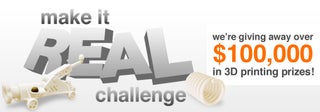Introduction: Heated Build Chamber for Rapman 3D Printer
This is an Instructable for a heated build chamber to house a Rapman 3.2 3D Printer. I chose the Rapman 3.2 because of it's relatively large print area, user friendly interface and the available dual extrusion upgrade. Assembly of the kit was simple and I found myself printing in no time; however, I soon began to experience warping in larger printed objects. After a bit of research, I began weighting the pros and cons of a heated build chamber vs a heated bed platform. The idea of a chamber was more attractive because I felt it would be easier for "me" to construct. I am no longer experiencing warping and there is also a noticeable dampening of the sound which the printer motors create.
The dimensions of the chamber are 32 in. width x 33.5 in. height x 24 in. depth. I would imagine that the chamber could accommodate a different 3D printer (such as a Prusa Mendel or similar RepRap) with or without (depending on the model) some modifications. Thanks for checking out this Instructable and if you have any questions, feel free to ask.
- Happy Building
Step 1: Project Overview
- The heated chamber is primarily constructed from Corrugated Plastic Sheets, bonded using a hot glue gun (mini). For the purpose of this Instructable I have divided the heated chamber into three color coded sections (see image above).
Step 2: Tools and Supplies
Supplies
- Rapman 3.2 3D Printer
- Reflectix 24 in. x 25 ft. Staple Tab Insulation Roll
- Plaskolite 24 in. x 36 in. Corrugated Plastic Sheets (11 sheets)
- LEXAN 11 in. x 14 in. Clear Polycarbonate Sheet (0.093 in. thick)
- Nashua Tape FlexFix 1-7/8 in. x 361 ft. Flex Duct Tape
- GE 18 in. Basic Plug-In Undercabinet Light
- Acurite Wireless Thermometer #00822A2
- Feature Comforts Ceramic Electric Heater #0042722
- Cabinet Hardware Pull
- Everbilt 2 in. Non-Removable Pin Hinges
- 6-32 x 3/8 / M2.8 x 9.5 Round Combo Bolt w/Nuts
- #6 Flat Washers
- #4-40 x 1/2" Round Head Bolt w/Nuts
- Glue Sticks
- White 1.88 x 20yd Duct Tape
- Double-sided Tape
Tools
- Glue Gun
- 36 to 48 in. Ruler
- Utility Knife
- Scissors
- Screw Driver
- Sharpie Marker
Step 3: Printing Files
The print files are attached below in PDF format. I broke them up into two files which can be taken to a local Fedex/Kinkos and printed using a wide format b/w printer. Another option would be to have the parts cut directly from Corrugated Plastic Sheets using a CNC Router. Each Corrugated Plastic Sheet measures 24 in. x 36 in. Print file 1 contains parts laid out over 5 sheets (120 in. x 36 in.) and Print file 2 contains parts laid out over 4 sheets (96 in. x 36 in.). If you choose to print the files using a wide format printer, once printed, cut both sheets every 24 in. vertically (this will result in nine 24 in. x 36 in. sheets). Next, use removable double sided tape to temporarily attach the printed sheets to the Corrugated Plastic Sheets. Use a ruler and a utility knife to CAREFULLY cut each shape out.
Note: To avoid damaging your floor, I suggest using an extra sheet of Corrugated Plastic as a surface to cut on.
Step 4: Assembling Chamber
Each part is labeled and can be assembled following the illustrations below.
Note: In case the jpegs are hard to view, I have also attached PDFs of each section (parts labeled) in steps 4,5, and 6.
Attachments
Step 5: Assembling Chamber Door
Attachments
Step 6: Assembling Heater Box
Attachments
Step 7: Final Assembly and Insulation
- Now that each section (chamber, chamber door and heater box) is assembled, it's time to apply the insulation.
- Using a black marker, pair of scissors and a hot glue gun, cover the inner walls of the chamber, chamber door and heated box with Reflectix Insulation. Use Nashua Flex Duct Tape to cover gaps and corners.
- Once each section is insulated, it's time for the final assembly. After mounting the GE 18 in. Basic Plug-In Undercabinet Light to the inside of CB1, attach the chamber door to CT1 with two Everbilt Hinges.
- The Heater Box can be attached to the Chamber just using Nashua Flex Duct Tape on the inside once the Heated Build Chamber is placed over the 3D printer (in it's permanent location).
Step 8: Print Results
- As stated earlier, I am no longer experiencing warping with my larger prints.
- I use an Acurite Wireless Thermometer to occasionally monitor the temperature inside of the chamber. Typically, I keep the temperature at around 95 °F.
If there are any aspects of this instructable which are unclear or if you wish for me to go into greater detail on a certain step, feel free to ask.

Participated in the
Make It Real Challenge












